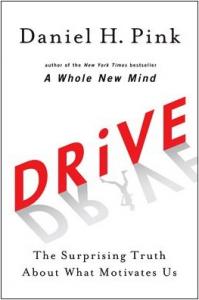Earlier this week, Dave began a discussion regarding motivation, which we hope has jump started your quest to be a better motivational force to those in your circle of influence. One of the purposes of WorkPuzzle is to help you apply science and thoughtful study to management topics. We believe this is the best way to separate what’s truly valid from those preconceived notions (that are often false) that keep us from producing the best results.
 A few weeks ago, I picked up a book called Drive: The Surprising Truth About What Motivates Us. This is the second bestselling book written by author Daniel Pink in the last couple of years, so he’s obviously tapping a nerve with the topics he covers in his books.
A few weeks ago, I picked up a book called Drive: The Surprising Truth About What Motivates Us. This is the second bestselling book written by author Daniel Pink in the last couple of years, so he’s obviously tapping a nerve with the topics he covers in his books.
I’ve found this book particularly intriguing. Pink does a great job of scientifically dispelling many of the misunderstandings I personally have concerning motivation. These misconceptions involve what I believe will motivate me personally and also what I’ve come to believe will motivate those around me. Over the next week or so, we’ll discuss a few of the highlights regarding Pink’s work. You’ll be surprised by what you learn.
Let’s start with the most commonly held motivation topic of all time—the proverbial carrot and stick. Through experience and study, I’ve come to the conclusion that there are many advantages to using incentives over punishments to motivate people. Of course, there are others who believe that punishments, applied correctly and under the right set of circumstances, serve as a better source of motivation.
There are good arguments on both sides of this topic, but Daniel Pink points out that scientific research has largely made this debate a moot point. Why? Because neither the carrot nor the stick motivation techniques are effective in most circumstances! In fact, deploying any sort of “if-then” reward system (if you do a task, then you get a reward) typically demotivates those performing a requested task.
To show you how this works, let's review an experiment originally conducted by psychologist, Karl Drucker, in the 1930’s. The experiment involved a participant being given the articles in the picture below (the items inside the box are common thumb tacks), and then being asked to attach the candle to the wall in a way that when lit, it will not drop any wax on the table below.
 Think for a minute how you would solve this problem. Most people first attempt to use the tacks to fasten the candle to the wall, but quickly discover that it doesn’t work. Some people then try to use a match to melt the side of the candle and stick it to the wall. That doesn’t work either. Eventually, after five to ten minutes, most people figure out that the tacks can be easily used to fasten the box perpendicular to the wall. This creates a shelf that the candle can be placed upon. A quick drop of melted wax securely attaches the candle to the shelf, and the shelf ensures that wax will not drip on the table. Problem solved.
Think for a minute how you would solve this problem. Most people first attempt to use the tacks to fasten the candle to the wall, but quickly discover that it doesn’t work. Some people then try to use a match to melt the side of the candle and stick it to the wall. That doesn’t work either. Eventually, after five to ten minutes, most people figure out that the tacks can be easily used to fasten the box perpendicular to the wall. This creates a shelf that the candle can be placed upon. A quick drop of melted wax securely attaches the candle to the shelf, and the shelf ensures that wax will not drip on the table. Problem solved.
This experiment has been used in many behavioral science studies over the years, but it wasn’t until recently that psychologists at Princeton University started to wonder if motivated individuals could solve the problem more quickly. Of course, to prove out this hypothesis, the researchers offered incentives (a carrot) to those people who could solve the problem quickly. The participants in the study were told they would receive a monetary reward if they were among the top (fastest) 25% who solved the problem in the group. Furthermore, the person who solved the problem first would also receive an additional, quite substantial, bonus.
Guess what happened? Remember, the problem usually took five to ten minutes to solve when no incentives were offered. When the participants were given incentives, it took an average of 3.5 minutes longer to solve the candle problem! The carrot produced the opposite result than what the researchers had hoped for and expected.
This is what makes motivation such a tricky topic. Well-intended interventions can not only fail to produce the desired results, but can often make things worse. It’s like going to a casino…you can not only fail to win, you can lose the money you bet in the first place.
In the case of the candle experiment, here’s what happened: The solution to the problem requires a certain level of creativity – In order to solve the problem, the subject has to eventually stop seeing the box as a container for tacks, and see it as a shelf for a candle. When the time incentive is offered, the brain starts to shut down some of its creative function and focuses more energy on winning the race. The very thing needed to win the race is being hampered by the carrot.
This is just one example of many studies where incentives have been documented to produce diminished results. In fact, the research now suggests that there are only a very few specific circumstances where “if-then” incentives produce better results (we’ll cover those in a future discussion). For the large majority of conditions, the carrot / stick motivation techniques serve to undermine performance.
We’ll delve into this in more detail in upcoming discussions. In the meantime, start to inventory your own personal behavior and pinpoint where carrot / stick motivation techniques have become part of the fabric of how you work with people.
Researchers can help us find better ways to motivate and inspire those around us, but the first step is to identify how and where our current efforts have backfired on us…
Editor's Note: This article was written by Ben Hess. Ben is the Founding Partner and Managing Director of Tidemark, Inc. and a regular contributor to WorkPuzzle. Comments or questions are welcome. If you're an email subscriber, reply to this WorkPuzzle email. If you read the blog directly from the web, you can click the "comments" link below.

